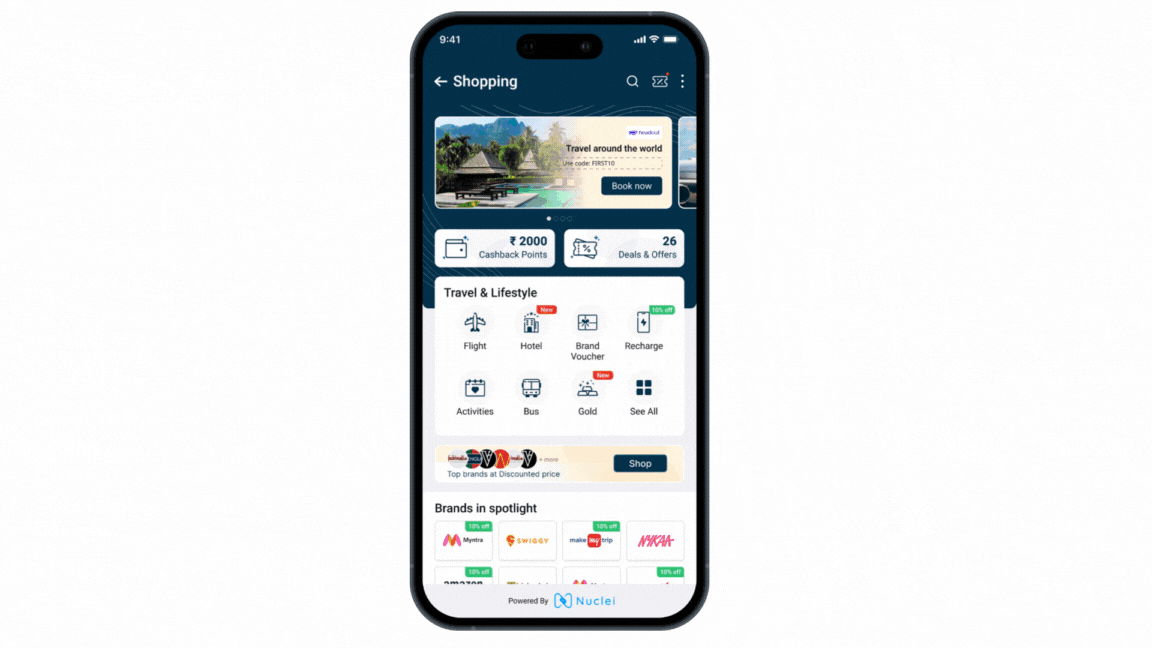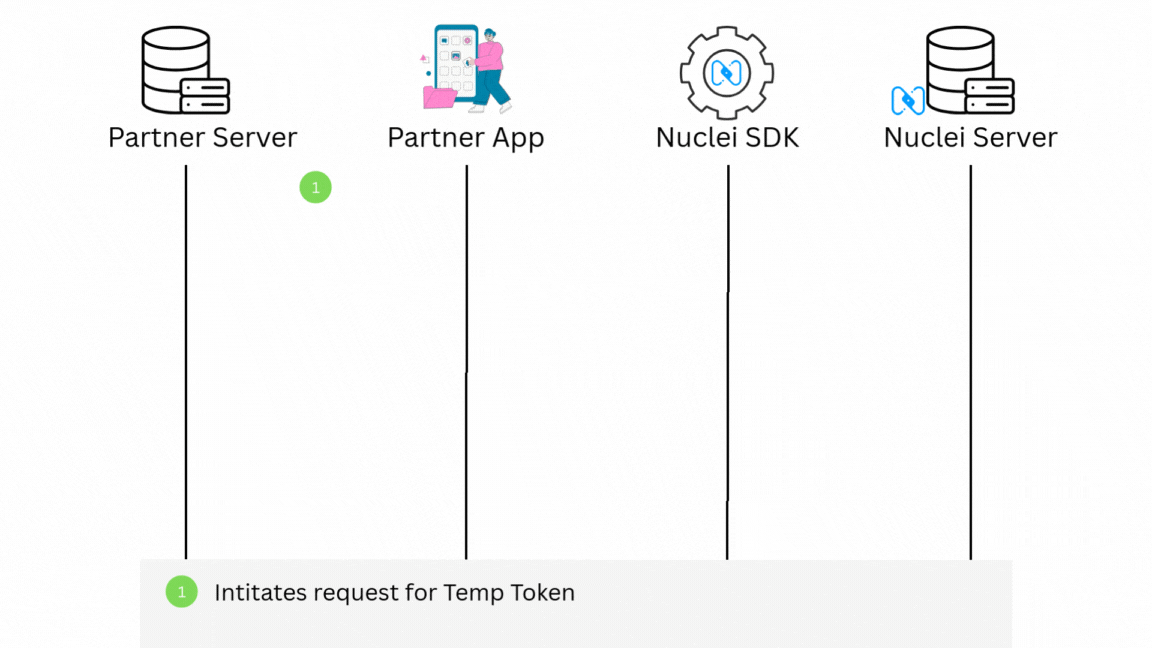Overview doc
Nuclei Merchant Marketplace SDK
by Nuclei ( CDNA Technologies Pvt. Ltd. )
What is Merchant Marketplace?
Merchant Marketplace is Nuclei’s retail ecosystem SDK that enables banking and telecom apps to offer a suite of services like Recharge, Hotels, Flights, Bus Bookings, and more — all within your app. This drives user engagement, boosts session duration, and improves retention.
Platform Support
Seamlessly integrates with:
- ✅ Native Android & iOS
- ✅ Flutter / React Native / Hybrid apps via plugin/native bridge
SDK Customization
The SDK supports:
- 🎨 Custom theme (match your brand colors)
- 🔠 Custom font

Category Types
| Category Type | Description | Examples |
|---|---|---|
| Native | Built inside SDK with native UI | Donations, Gold, Billpayments |
| Svelte | WebView-based UI, opens in-app, OTA updates | Recharge, Flights, Bus, hotels, GiftCard, Experiences |
| Synapse | WebView-based UI, External 3rd-party integrations | 1MG, ClearTax, Dpanda, ONDC, Stamp the Passport |
User Journey Flow

-
The user launches the partner application.
→ The Nuclei SDK is initialized using partner-specific attributes. -
The user taps on a Nuclei SDK entry point (e.g., a Recharge tile).
→ If the user is not logged in, the Nuclei SDK intimates the partner app to initiate seamless login. -
The selected category screen (e.g., Recharge, Hotels, etc.) opens.
-
The user browses the content and selects a service or product.
-
On the review page, the user verifies details and clicks “Proceed to Pay.”
-
The partner’s payment page is launched where the user completes the payment.
-
Upon successful payment, the Order Details page is displayed. ✅ The entire experience is seamless from the user’s perspective.
Seamless Login Flow
Seamless login is invisible to the user. It is handled entirely through background processes initiated by your app. It gives user a Seamless feel.
In case, User opens a nuclei category and user is not logged in to nuclei, Nuclei intimates partner app to initiate Seamless login through callback.
Flow:

-
The Partner App initiates the seamless login process.
-
The Partner Server sends a request to the Nuclei Server to generate a temporary token, using a unique user identifier.
-
The Nuclei Server returns the temporary token to the Partner Server.
-
The Partner Server forwards the temporary token to the Partner App.
-
The Partner App passes the temporary token to the Nuclei SDK.
-
The Nuclei SDK validates the temporary token with the Nuclei backend.
-
Upon successful validation, the Nuclei Server issues a JWT token, which is securely stored by the Nuclei SDK.
- 🔐 JWT valid for 3–4 months (configurable)
- 🔁 On expiry, SDK triggers re-login via the same flow
For more information on the seamless login flow, refer to Seamless Login Overview.
Transaction Flow
Once logged in and inside a service:
- User selects product (e.g., recharge plan, hotel)
- Clicks Pay Now on Review cart Page.
- The user is redirected to either:
- 🏦 Bank Payment Page (e.g., Netbanking)
- 💳 Integrated Payment Gateway (e.g., UPI, Cards, Wallets)
- After completing the payment, the Partner Server is responsible for notifying Nuclei about the final status of the transaction through the Callback API. (In case of Partner handling Payments)
- If the Callback API is not received within a reasonable time frame, Nuclei polls the Payment Status API at a configurable interval for a fixed number of attempts to get the final status of the transaction. (In case of Partner handling Payments)
- User is shown the terminal state on Order details Page.
APIs for Integration
From Nuclei
| API | Purpose |
|---|---|
Generate Temp Token | To generate token for seamless login |
Callback API | Called by partner to notify transaction status |
From Partner
| API | Purpose |
|---|---|
Payment Status API | To get the payment status of a particular transaction |
Refund Initiation API | To initiate refund for a particular transaction |
Refund Status API | To get the refund status of a particular refund transaction |
SMS API | Optional. Send SMS for successfull fullfillment to users |
For more information on the Generate Token API, refer to Generate Temp Token Overview.
For more information on the Payments API, refer to Payments Overview.
Integration Lifecycle
- IP Whitelisting
- Exchange of static IPs for mutual access (server to server communication)
- SDK + API Integration
- Add SDK, wire up APIs
- UAT (Testing)
- Nuclei and partner test all category flows
- CUG (Closed User Group)
- Small live rollout for testing with real users
- Production Launch
- Full launch to all users